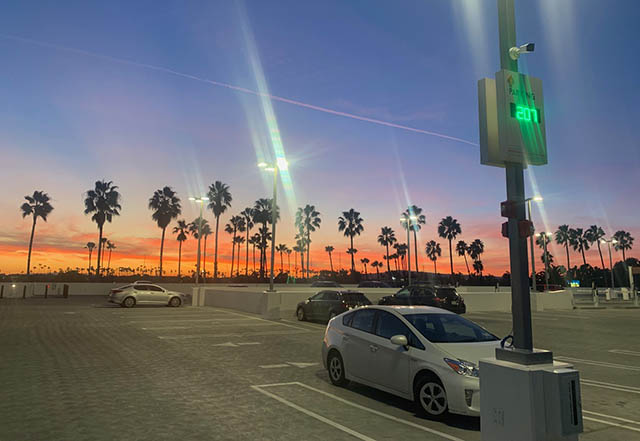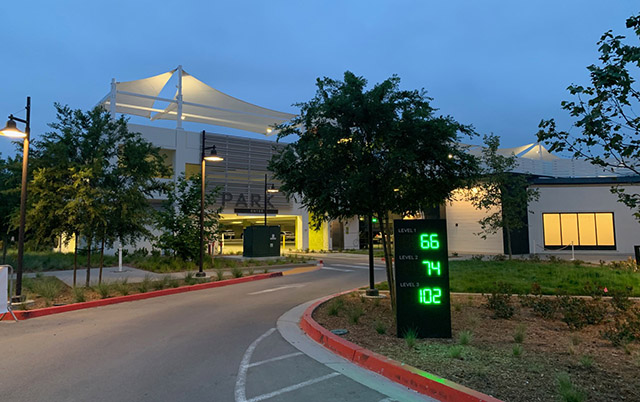Simple Parking Guidance for Colleges and Universities
Parking guidance also offers tremendous administrative benefits to colleges and universities by keeping track of how their parking assets are being utilized.
- By Chris Scheppmann
- 02/21/20
Colleges and universities have been among the largest beneficiaries of the parking industry’s ongoing technology revolution. More efficient and customer-friendly access and revenue control equipment (the gates that allow access and egress), cloud-based permitting software, more advanced safety equipment and other advances have dramatically improved campus parking at universities across the United States.
One of the most important technologies to be introduced in recent years is parking guidance. The technology uses sensors to keep track of how many spaces are available in a parking facility, as well as on individual floors, and transmits that information to strategically placed signage to help direct drivers to available parking spaces. On a large campus, the technology can help students, faculty, students and visitors find parking in a fraction of the time it usually takes.

Photo courtesy of EnSight Technologies
It’s easy to see why parking guidance technology would be popular on college campuses. It dramatically improves the parking experience, and drivers no longer need to waste valuable time searching for a parking space.
Parking guidance also offers tremendous administrative benefits to colleges and universities by keeping track of how their parking assets are being utilized. When campus parking administrators have access to real-time data about how their parking facilities are being utilized, whether they are at full or near-full capacity and when they tend to be busiest, they can make better decisions about how to manage those parking resources. Better and more comprehensive information tends to lead to better management decisions. It easy to see how parking guidance offers a classic win/win scenario: drivers get a better parking experience, while colleges and universities improve their operations and make more money.
Intelligent Simplicity
Parking guidance has been extremely popular among colleges and universities over the past decade, and today, because of technological advances making it simpler to operate and much less expensive, it’s more accessible than ever. Everyone loves the concept of parking guidance, but when it comes down to it many institutions were scared away by the cost. When the technology was introduced, owners had just two options: install sensors over every parking stall at considerable expense, or use less expensive technology that could often be inaccurate and, as a result, not particularly useful. A complete over-the-space sensor system could cost anywhere from $500 to $750 per space, given infrastructure limitations and signage requirements. So, for a garage with just 500 parking spaces, the cost of installing a reliable guidance system would run around $250,000 and could run as high as $375,000. And that’s just the initial installation cost. There may also be maintenance and repair costs to factor in.
Today, however, colleges and universities can take a more streamlined, simple approach to parking guidance. A simplified parking guidance system that leverages the latest advancements in vison-based software technology to track, identify and count cars can provide accurate guidance at a fraction of the cost. The software can recognize the difference between specific objects — such as cars, people, motorcycles, scooters — and precisely count only those vehicles that will be parked. Intelligent cameras are located at the main entries, entrances and exits of individual parking floors, and even specific zones, in order to monitor incoming and outgoing traffic. The cameras count how many cars enter and exit the structure, as well as each individual floor. That data is compiled and analyzed in real time to determine how many spaces are available in the parking facility as a whole, as well as on each floor.
The data is then transmitted to strategically located LED signs located at the facility’s entrance and at the entrance of each floor. When people drive into the garage, the entry sign tells them how many parking spaces are available at that moment throughout the garage. As they drive through the facility, signs at each level tell them how many spaces are available on that particular level at that moment.
For larger garages, it may be advisable to install additional cameras and signs to serve individual sections of a parking floor to provide more detailed information about how much parking is available in those sections. The system is also scalable to allow for the strategic individual monitoring of specialty parking spots such as ADA, Short Term Dropoff or VIP Rewards spaces.
This simpler approach to parking guidance can provide a much more convenient parking experience at a fraction of the cost of single-space parking guidance. It’s easy to see why the cost is much more manageable, since owners and operators only need to install a handful of cameras rather than hundreds of sensors. The technology can also be centrally connected so campus managers can tell at a moment’s notice how many spaces are available on campus at a given time.

Photo courtesy of EnSight Technologies
Like other forms of parking guidance, the systems also provide valuable information that can be used to better manage parking resources. The data is collected and transmitted to a cloud-based management portal. Live garage metrics and reporting tools are accessible anytime, anywhere, from mobile device, tablet or computer. Administrators can visualize how many vehicles park in their parking facilities — or throughout campus — every day, which sections of a facility are most popular and which hours and days are busiest. This information can be used to better manage campus parking. When you know how your parking resources are being used, you can make better decisions about how to manage those resources. Parking guidance technology provides that information.
Guidance in Reach
Parking guidance technology is a valuable tool for helping provide a better campus parking experience, while at the same time improving parking operations. For those colleges and universities that have avoided investing in the technology because of the expense, the simpler, streamlined approach may provide the answer because it is much less expensive, more manageable and provides parkers with enough information to make smarter parking decisions. Simple guidance is the next step in the evolution of campus parking guidance technology.
About the Author
Chris Scheppmann is managing member of EnSight Technologies, a leading parking guidance provider. He can be reached at [email protected].